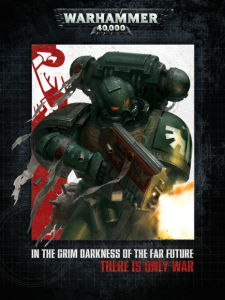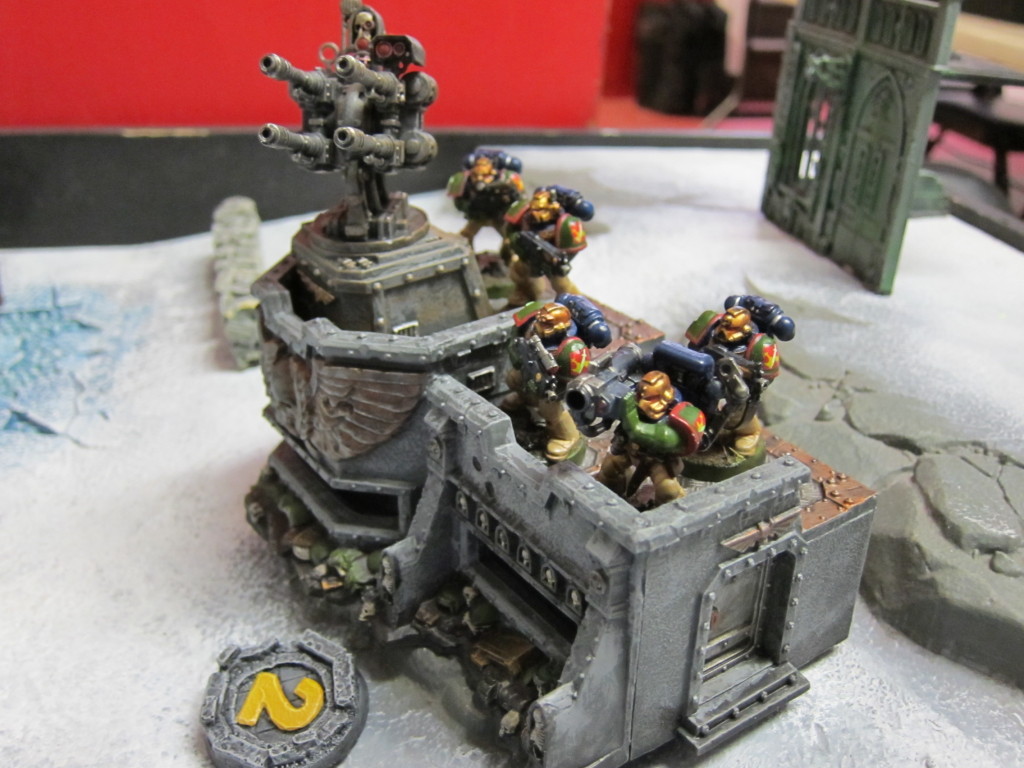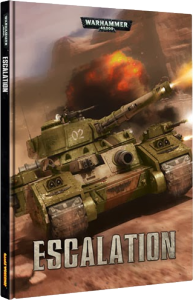 With GW seriously ramping up its book and model output for 40k over the past year, and 6th and now 7th editions having wide open army construction rules, there are some crazy combos out there. A lot of tournaments have already applied or are talking about restrictions such as “Your army must come from 2 sources.” That seems pretty reasonable to me. But, particularly now with 7th edition, I think it’d be better to define the restriction in terms of “2 factions.”
With GW seriously ramping up its book and model output for 40k over the past year, and 6th and now 7th editions having wide open army construction rules, there are some crazy combos out there. A lot of tournaments have already applied or are talking about restrictions such as “Your army must come from 2 sources.” That seems pretty reasonable to me. But, particularly now with 7th edition, I think it’d be better to define the restriction in terms of “2 factions.”
Factions
Previously I don’t think 40k had a formal definition of “faction.” This edition though actually has a fairly clear one, on page 118. Some obvious things are made formal, following the traditional notion of each codex book as a faction. For example, Salamanders Space Marines aren’t a faction while Blood Angels are. It also specifies that all the units selected from a codex are of that faction unless noted otherwise, even in the now common case that the unit exists in multiple codexes. More usefully, in a needed formalization, the section also explicitly says that all the units in a codex supplement belong to that codex’s faction.
Sources
The primary problem with restrictions based on “sources” is specifying what counts as a source.
For example, I doubt most people would object to a Space Marine detachment allied with Imperial Guard. But suppose I want to include an Aegis Defense Line or Imperial Bunker? That also seems totally reasonable. But that’s now three distinct books: The Space Marines and Astra Militarum codexes, plus Stronghold Assault. Note that ADLs, Bastions, etc., have all been removed from the core rulebook in this edition, so lots of people will presumably be grudgingly buying and wanting to use the Stronghold Assault book. Even with diminished quadguns and other skyfire weapons, with scoring permitted from buildings, improved/clarified Void Shields, and D weapons in the core game, I expect bastions and such to return in popularity; I’ve been a fan of the Imperial Bunker since the book came out. Generally I think the fortifications in Stronghold Assault are pretty reasonable and not overpowered, so it or some subset should almost definitely be allowed in nearly all tournaments. The main question to me is whether or not to allow D weapons, from any book, not just Stronghold, the answer to which should probably be the same answer to whether or not to allow Stronghold’s mighty bulwarks and other buildings with AV15.
The problem is then what to do about defining “sources,” because that quite reasonable Space Marine + IG + ADL/Bunker army has three. You can’t just arbitrarily allow three sources and hold to the original intent of the restriction because then somebody brings some ridiculous Tau + Eldar + Necron combo or such, eliminating which is the whole point of the exercise.
You could carve out Stronghold Assault as not counting toward the source limit, but then you get stuck into an ever deepening hole of special exemptions to what counts as a “source.” Does Escalation count as a source, assuming it’s permitted? What about Codex: Imperial Knights? Assuming you’re willing to allow at least a subset of the units in any of those books into the game, you now have all the same problems. More challenging, suppose GW puts out a new, modest fortification model in the near future, and includes rules in the box as they initially did with some of the latest pieces? Or publishes a new variant or updated rules for an existing unit in White Dwarf? Do those count toward the source limit? At that point you’re looking at either limiting people’s army selections, which might be reasonable in a heavily competition oriented event like a GT but less so otherwise, or you’re building complex lists of exceptions and periodically updating them according to GW’s production whims.
Similar to all of that are the supplements. Say I want to field Codex: Space Marines plus Sentinels of Terra as my core army. Does that hit my two source limit already, prohibiting any allies, knights, fortifications, or superheavies ? As another, presumably very common possibility, what about Codex: Chaos Space Marines + Black Legion + Codex: Chaos Daemons? It would be unduly limiting to include supplements in the sources count, but to not do so then the definition of “sources” needs to spell that out. But then what if some supplement down the line includes units it explicitly puts into different factions?
Dataslates + Formations
A closely related question then is whether or not to include dataslates and formations. Caveat some other explicit restriction, under the “factions” terminology they would be included, and you could use several at once provided they stayed within the faction limit. Notably, though they would be limited in number, the “sources” phrasing would also permit you to take one, which could be all you need to cause trouble, assuming there is trouble to be had. There definitely could be or possibly already are some formations or dataslates that are not desirable but fall within the two sources limit, permitting codex + ebook.
Whether or not to include these is a whole separate topic. One important quick point though is that though often lumped together, these should be considered separately. Other than some potential absurdly powerful unit, dataslates introducing a new model/unit variant are almost always going to be much less problematic than formations, which either introduce new benefits with no additional cost or enable crazy quantities or combos of units. Restricting these should be considered separately, and it wouldn’t surprise me at all for many tournaments to say yes to dataslates but no to formations.
My main point here is that in regards to dataslates and formations, the “sources” phrasing doesn’t do a particularly better job than “factions” at getting to the heart of the problem despite all the extra baggage outlined above. Either way you cut it, additional rules are needed, and it’s cleaner to phrase them in terms of factions. For example, I suspect some of the worst formation problems could be dealt with by saying “No more than 1 detachment of any given faction is permitted.” There would be some collateral damage there, like preventing the Codex: Space Marine chapters from allying with themselves. But unless I’m mistaken it would also very cleanly prevent builds I believe to be generally considered problematic, like the Tau Empire + Farsight Enclaves + Firebase Support Cadre combo.
Formal Terms
All in all, it’s much more elegant to simply say “Armies may include at most 2 factions” rather than restricting sources. That gets at the heart of the problem, preventing crazy non-traditional army combos, while still cleanly and clearly allowing in the various codex supplements and expansions. Obviously there could be other rules, say to exclude D weapons and AV15, permit only 2 detachments, or exclude formations, but they’ll all be sitting on a much more clear and formal framework. In general, it’s almost always simpler, more effective, and causes less collateral damage to do these kinds of restrictions in terms of formal game concepts like “faction” or “buildings with AV15” rather than informal, external ephemera like which source/book a unit came from—particularly as it could come from several—or the ostensible manufacturer, i.e., restricting Forge World.
Summoning
As a final note, regardless of the phrasing in terms of “sources” or “factions,” some clarification should be made regarding conjurations. If I’m using the malefic powers in the core rulebook and summoning units from Codex: Chaos Daemons, as it explicitly notes, does that count against my sources/factions limit? Much as it horrifies the fluffy player in me, you could certainly have somebody now with a totally reasonable main list of just Space Marines + Astra Militarum + Stronghold Assault who is also putting Chaos Daemons on the board in-game. Again, any clarified permission or enforced restriction here should be made in formal game terms and be crafted to be proof against potential future codex and supplement updates, i.e., not specifically about Chaos Daemons or malefic powers. It wouldn’t shock me at all for some future army or unit to have powers to summon something besides daemons, like an Eldar Avatar, Ork golem of Gork (or Mork), or something akin to the Space Marine Legion of the Damned. I would guess such a rule or clarification should be phrased along the lines of something like:
- Permissive: Units created by conjuration powers do not count against a player’s faction limit even if they are of a different faction from those used in the player’s army list.
- Restrictive: Units created by conjuration powers count against the number of factions permitted to be fielded by a player.
Note that in terms of these kinds of restrictions the latter basically means you’re taking Chaos Daemons as an ally if you use the malefic conjuration powers, whether or not you have any daemons in your starting list.




